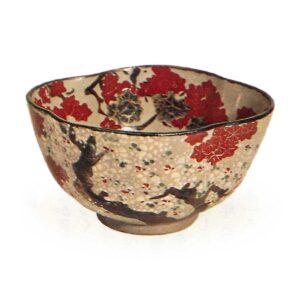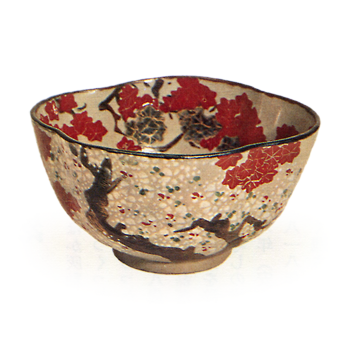
Takahashi Dohachi is a potter from Kyoto. Dohachi was the first generation of the Dohachi family to be named Myoko-kou (master potter), beginning with Dohachi I during the Horeki era (1751-64).
The first generation was named Takahashi Shuhei Mitsushige and went by the name Shofutei Kuen. He was the second son of Takahashi Hachirotayu, a warrior of the Kameyama domain in Ise Province (Mie Prefecture), who lived in Kyoto during the Horeki era and was so impressed by the pottery he saw being made at Sanjo Awataguchi that he settled there and began his own pottery business. While carving bamboo and wood, he also enjoyed the pleasures of elegant recreation, and was a constant companion of Ike Taiga, Ueda Yosai, and others. He also studied nanga (southern-style painting) and made his own ceramics, which he painted and fired. The second Michihachi, whose name was Kōtoki, also went by the names Shōpū, Kachutei, and Hōrazanjin. He succeeded his father in the production of ceramics and Raku ware, and moved from Awata to Gojo in 1811. He moved from Awata to Gojo in 1811, where he specialized most in portraits, animals, fish, and shellfish, and was a master at copying old vessels. At the age of 42, he became a Buddhist disciple of the high priest Mikurain Sonken, the head of Ishiyama-ji Temple in Omi Province (Shiga Prefecture), and became a hairdresser. Because of his skill with products, he was given the Chinese character “Jin”, which especially suited his family’s wishes, and because he believed in Buddhism and became a disciple of the Buddha, he was given the name Ami by the court of Sanboin in Daigo, and was named Nin’ami. Later, he was allowed to succeed to the Doji family name and took the name Takahashi Hohashi Doji Niami. Kiyomizu-yaki was made only of ceramics, and porcelain was scarce, but Niami explored the tomb ware of Annan from the Fukiko kiln and created perfect white porcelain and blue-and-white porcelain, gaining widespread fame. Because of his skillful technique, he received special protection from lords and distinguished persons, and was frequently requested by the Tokugawa family of Kishu, the Mabe family of Kyoto, the Ooka family of Nijo Castle, the Shinmyouin family of Nishi Honganji, the Seirenin Awata family, the Daibutsu family, the Matsudaira family of Sanuki (Kagawa Prefecture), the Naito family of Fushimi Magistrate, the Shimazu family of Satsuma (Kagoshima Prefecture), the Ishikawa family of Ise (Mie Prefecture), the Nikko family, etc. The Kishu family, the Sanbo family, and the Kishu family were among them. In August 1842, he left his family to his son Dosan and retired to Momoyama, a village in Fushimi (Fushimi-ku, Kyoto), where he established his own small kiln under the name “Michiou” and called it Momoyama-yaki (Momoyama pottery). He died in May 1855 at the age of 73. The third Dohachi was named Kouei and went by the name Huachutei. He was the eldest son of the second Dohachi. His childhood name was Dozo, and he loved pottery making since he was a boy, and fired pottery behind his father’s back. When his father, Nidoami, was invited by the Kishu family to visit Kii (Wakayama Prefecture), he went with his father to make an incense container for Usuume, and was especially honored because it was as good as his father’s. He was 16 years old. After returning home, he attempted to make his own Raku ware, semi-polished porcelain, and Annam copy of incense containers behind his father’s back, and finally succeeded. Within two years, he was able to produce blue-and-white porcelain and white porcelain, and he also studied nanga (Chinese painting) under Ike Taiga. He was also impressed by a matcha bowl by Insei, and made it in his own way. He followed his father’s style in handmade work, and his skill with figures, animals, fish and shellfish was more detailed than his father’s. He was most skillful in celadon, cloud cranes, mishima, and brush marks. At the end of the Tempo period (1830-44), he produced basket-shaped vessels. He also invented the technique of blending shades of gray under the glaze in underglaze blue-and-white paintings, as well as improved various glaze agents. In 1869, he went to Arita, Hizen, to teach pottery-making methods. In 1874, he handed over the family business to his eldest son Mitsuyori, who, like his father, was engaged in Momoyama-yaki (Momoyama pottery), and died in August 1879 at the age of 69. Mitsuyori IV, whose name was Kanchutei Dohachi, was born in 1845 (Koka 2). His childhood name was Yoritaro, and he was mild-mannered with excellent discernment. He improved the glazes of his family’s method and also invented a number of things. In 1873, he was appointed as an official of the Kyoto Prefectural Government, where he improved the shapes of stationery, floor decorations, and tea and drinking utensils by blending Japanese, Chinese, and Western ceramics, and he also invented the first plaster molds. He also used plaster molds for the first time and taught the method to his colleagues on Gojozaka, where he was greatly praised. Since then, he was elected as a judge at expositions, an official of the Kyoto Prefectural School of Painting, vice president of the Ceramic Merchant Association, and a professor at the Kyoto School of Arts and Crafts, and received countless awards and prizes. He was succeeded by Eikoh V, who assumed the name Kanakutei Dohachi. Shuhei Ogata was the brother of the second Dohachi. (Morisada Manuscript, Kanko Zusetsu, Kogei Kagami, Dai Nihon Kogyo Kyokai Zasshi, 62, Geizo Yonjyoku, History of Arita Porcelain Industry, and History of Sanuki Ceramic Porcelain)



